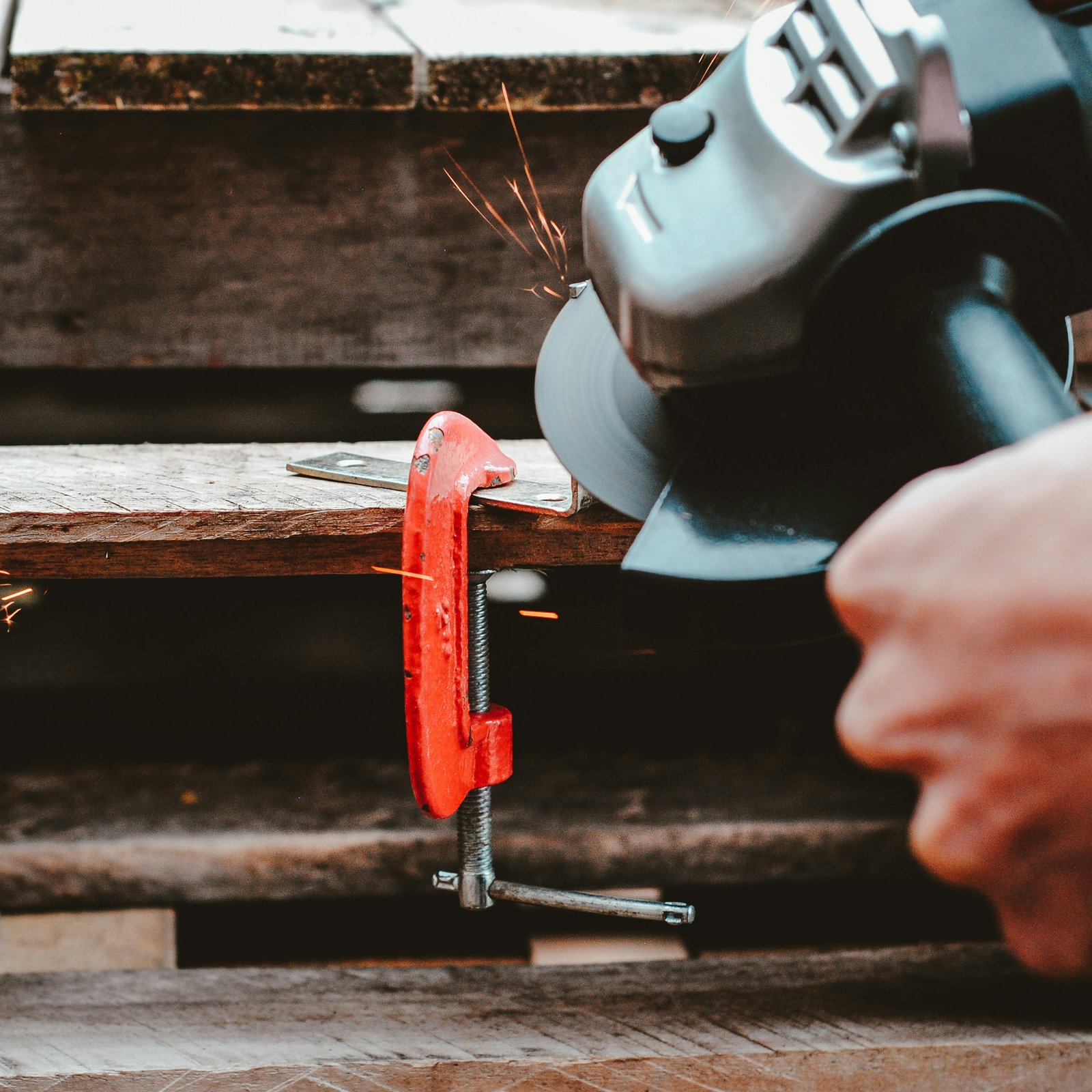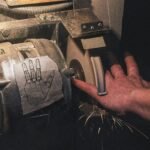Understanding Angle Grinders
Angle grinders are versatile power tools commonly utilized in welding and metalworking tasks. Their primary function revolves around grinding, cutting, and polishing various materials such as metal, concrete, and masonry. Typically powered by electric or pneumatic sources, these tools have a rotating abrasive disc that enables users to perform an array of functions effectively and efficiently.
In the realm of welding, angle grinders play a crucial role in preparing surfaces for welding and cutting through metal components. For instance, they can be employed to bevel edges of metal pieces, ensuring a perfect fit for welding. Additionally, they can clean welds and remove slag, which is essential for achieving smooth surfaces and strong joints. The ability to swap out different discs—ranging from grinding wheels to flap discs—further enhances their utility, allowing users to tackle diverse tasks depending on their project requirements.
Moreover, angle grinders come in various sizes and types, catering to different applications and user preferences. For example, 4.5-inch and 7-inch models are common size choices, with smaller units typically being lighter and easier to handle for detailed work, while larger models offer more power for heavy-duty tasks. The specific features of an angle grinder, such as variable speed controls and ergonomic designs, can significantly influence their effectiveness and user experience.
In sum, the angle grinder is an indispensable tool in welding and metalworking, offering a combination of speed and precision. Understanding the key functions and capabilities of this tool is vital for anyone looking to achieve professional results in their welding endeavors.
Types of Angle Grinders
Angle grinders are versatile tools that come in various types, each suited for different applications, including welding. Understanding the differences between pneumatic, electric, and battery-operated angle grinders can help users choose the best option for their specific needs.
Pneumatic angle grinders are powered by compressed air, making them ideal for heavy-duty applications. These tools are lightweight and provide high RPMs, which enhances their efficiency in cutting and grinding tasks. One of the main advantages of pneumatic models is their durability; they have fewer moving parts compared to electric grinders, resulting in lower maintenance. However, they require an air compressor, which can limit their portability and increase setup time in some environments.
Electric angle grinders are the most common type found in workshops and construction sites. They are powered by electricity, offering a reliable and continuous source of energy for extended use. Electric grinders come in various power ratings, allowing users to select a model that aligns with their specific welding project requirements. The main advantage of this type is the ease of use and widespread availability. However, electric models can sometimes be restricted by the power outlet location and may not be as portable as battery-operated options.
Battery-operated angle grinders offer enhanced mobility due to their cordless design. These tools are ideal for outdoor or remote welding projects where access to power outlets is limited. Modern battery-powered models boast significant advancements in battery life and performance. Their main disadvantage, however, lies in their runtime; users may find themselves needing to recharge the batteries frequently, especially during intensive grinding tasks. Overall, the choice between pneumatic, electric, and battery-operated angle grinders ultimately depends on the specific project requirements and working environment.
Key Specifications to Consider
When selecting an angle grinder for welding, it is imperative to consider several key specifications that significantly impact its performance. Understanding these specifications will enable you to choose a model tailored to your specific welding tasks.
First, the power rating of an angle grinder, typically expressed in amps or watts, is a critical specification that directly influences its efficiency and capability. A higher amperage usually equates to greater power output, allowing the grinder to handle tougher welding jobs. Generally, for welding applications, an angle grinder with a power rating ranging between 7 to 15 amps is recommended. This range ensures that the tool can accommodate various materials and thicknesses without straining.
Next, the spindle size is another vital aspect to consider. Common sizes include 5/8-inch and 7/8-inch, affecting the compatibility with different attachments and accessories. A grinder with a larger spindle size may offer greater versatility, as it can accommodate a wider range of discs, including those specifically designed for welding tasks.
The disc diameter is also crucial, traditionally varying from 4.5 inches to 9 inches. A larger disc diameter allows for increased coverage during operation, which can be particularly beneficial for larger welding projects. However, users should balance size with the grinder’s weight and ease of handling, as a heftier model may lead to fatigue during extended use.
Additionally, the revolutions per minute (RPM) rating determines the grinder’s speed and efficiency in cutting or grinding materials. Higher RPMs enable quicker results but require careful consideration of the material being welded to avoid damaging it. Most angle grinders have an RPM range between 5,000 to 10,000. Choosing a model with adjustable RPM settings can further enhance its usability across different welding projects.
Wattage and Power Rating Explained

When selecting an angle grinder for welding applications, understanding wattage and power rating is crucial. Wattage is indicative of the energy consumption of the grinder, while the power rating, often expressed in volts or amps, reflects the tool’s operational efficiency and capability. A higher wattage typically suggests a more powerful motor, which can significantly enhance performance, particularly during demanding tasks such as welding.
In welding, the function of the angle grinder is to prepare surfaces, clean welds, and sometimes shape metal. Therefore, the power of the tool directly affects its efficiency. For instance, when working with thicker materials, a grinder with a wattage of at least 1,200 watts is often recommended. This level of power aids in maintaining performance without the tool stalling, ensuring a smoother operation on challenging materials. Conversely, for lighter tasks involving thinner metals, a lower wattage grinder can suffice, allowing for precision and finesse without unnecessary power.
Moreover, it is essential to acknowledge the importance of choosing a grinder with an adequate power rating that aligns with the specific materials being prepared or welded. For example, when working with stainless steel or high-strength alloys, a higher wattage not only provides sufficient torque but also mitigates the risk of overheating, which can compromise the integrity of the metal. In contrast, if one is engaged in lighter, less demanding projects, selecting a tool with 600 to 800 watts may be sufficient.
In summary, understanding the significance of wattage and power rating is pivotal for ensuring optimal performance in welding applications. Selecting the appropriate grinder based on project requirements can lead to improved efficiency, durability, and results in the welding process.
Safety Features to Look For
When selecting an angle grinder for welding, understanding the safety features is essential to ensure a safe working environment. Given the potential hazards associated with welding, an angle grinder equipped with effective safety features can significantly reduce the risk of accidents and injuries. One of the most critical features to consider is the presence of a disc guard. This guard acts as a protective barrier, preventing debris and sparks from being thrown towards the user, thereby enhancing overall safety.
Another important safety feature is anti-vibration technology. Using an angle grinder can subject the user to considerable vibration, which may lead to discomfort or even long-term health issues such as hand-arm vibration syndrome. An angle grinder with well-designed anti-vibration systems can help mitigate these effects, resulting in a more controlled and comfortable operation.
Moreover, the incorporation of electronic speed controls in angle grinders is a significant safety feature. This functionality allows for better management of the tool’s speed, ensuring that it can be adjusted according to the specific welding tasks at hand. Such control not only enhances the quality of the weld but also minimizes the risk of the tool malfunctioning or becoming unwieldy during operation.
Other safety features to consider include adjustable handles and well-positioned switch mechanisms to prevent accidental activation. Additionally, ensuring that the angle grinder meets relevant safety standards and certifications is vital. By being vigilant about these safety features, users can create a safer working environment, prevent accidents, and maintain a smoother workflow during welding tasks.
Best Brands and Models for Welding
When it comes to selecting an angle grinder for welding, choosing a reputable brand can significantly enhance performance and reliability. Notable brands in the angle grinder market include Makita, DeWalt, Bosch, and Milwaukee. Each of these brands has consistently proven their commitment to quality and innovation, making them top choices for welding applications.
Makita is recognized for its high-performance angle grinders that offer robust power and superior ergonomics. The Makita GA7021, for instance, is a heavy-duty model equipped with a 15-amp motor that delivers 8,500 RPM, making it suitable for cutting and grinding metal under challenging conditions. Its protective zig-zag varnish seals internal components from dust and debris, which is essential for the longevity of the tool in welding settings.
Another brand worth mentioning is DeWalt, which is synonymous with durability and efficiency. The DeWalt DWE402 is a standout model featuring a 11-amp motor that provides a high rotating speed of 11,000 RPM. Its paddle switch and safety lock-off feature improve user control, which is critical when performing precise weld preparations. This model is particularly noted for its lightweight design, facilitating ease of use during extended welding sessions.
Bosch has a reputation for producing reliable tools that combine performance with user-friendly features. The Bosch GWS18V-45 is an excellent cordless option, powered by a brushless motor that extends battery life while providing ample torque. Its compact design makes it ideal for tight spaces encountered during intricate welding tasks.
Finally, Milwaukee is another esteemed brand in the industry, and the Milwaukee 2780-20 offers impressive power and cutting efficiency. This angle grinder features a 18-volt power system that generates 8,500 RPM and integrates advanced technology to deliver consistent performance. Milwaukee’s focus on user safety, coupled with innovative design, positions them as reliable options for professional welders.
Accessories and Attachments
Angle grinders are versatile tools commonly utilized in welding tasks, and their effectiveness can be significantly amplified with the right accessories and attachments. These enhancements allow users to perform a wide array of tasks, ranging from cutting and grinding to polishing and finishing, making it essential to select the appropriate add-ons for specific applications.
One of the most common accessories for an angle grinder is the cutting disc. These discs are perfect for slicing through metal and other tough materials, enabling smooth and precise cuts. The actual performance of an angle grinder in welding can greatly depend on the type and thickness of the cutting disc used. For instance, thin discs provide cleaner cuts, while thicker variants offer more stability, which is especially crucial for heavy-duty welding tasks.
Another significant accessory is the flap disc, which combines the functionality of sanding and grinding into one. Flap discs are designed with overlapping layers of abrasive material that allow for efficient material removal while minimizing the risk of gouging or damaging the workpiece. Their versatility makes them ideal for preparing surfaces prior to welding, ensuring a better bond and finish.
Wire brushes also serve as valuable attachments for angle grinders, particularly in cleaning applications. Specifically designed for weld preparation, wire brushes help remove rust, scale, and other contaminants from metal surfaces. This accessory enhances the overall performance of the angle grinder in welding tasks by ensuring that surfaces are clean and ready for effective welding, thereby contributing to improved weld quality.
In summary, the selection of accessories such as cutting discs, flap discs, and wire brushes can significantly contribute to the performance and effectiveness of an angle grinder in various welding tasks. Adaptation of the right tools enhances not only the ease of work but also the final output quality, making careful consideration of these attachments crucial for all welding projects.
Budget Considerations
When selecting an angle grinder for welding, establishing a practical budget is essential to ensure that you make a well-informed purchase that aligns with your needs. The prices of angle grinders can vary significantly, typically ranging from around $30 to $500. While it’s possible to find inexpensive models, these often come with trade-offs in terms of quality, durability, and performance. Higher-end models may offer superior features and build quality, which can translate to longer-term value.
It is fundamental to recognize the relationship between price and quality when determining your budget. Generally, a more expensive angle grinder will provide better motor power, enhanced safety features, and superior ergonomics, all of which are critical for effective welding tasks. However, it’s important to note that the most expensive option is not always the best choice for every user. Individual requirements, frequency of use, and the specific welding projects one intends to undertake should guide the selection process.
One effective approach to balancing cost with necessary features is to prioritize essential functionalities that are crucial for welding. For instance, look for an angle grinder with adjustable speed settings, as this allows for greater control during different welding tasks. Additionally, features such as dust protection, vibration reduction, and comfortable grips are beneficial for prolonged use and increased safety. Consider also the availability of warranties and customer support, which can further justify a higher investment. By carefully assessing your needs against the features offered at various price points, you can make a more informed decision that fits within your budget while ensuring you acquire a reliable angle grinder for your welding projects.
Conclusion and Final Thoughts
In this comprehensive guide on selecting the best angle grinder for welding, we have emphasized several critical factors that contribute to making an informed decision. Choosing the right angle grinder is essential not only for effective performance but also for ensuring safety and efficiency during welding projects. A well-selected grinder can significantly enhance the quality of your work and ease the entire welding process.
Throughout the discussion, we highlighted the importance of considering specific features such as power output, disc size, and safety mechanisms. These elements influence both the effectiveness of the tool and the safety of the user. Moreover, understanding the various types of angle grinders available on the market, including corded and cordless models, is vital for meeting individual project requirements. Corded grinders usually deliver continuous power, ideal for demanding tasks, while cordless options offer portability and flexibility for non-stationary jobs.
Safety should always be a top priority when working with power tools. Therefore, it is crucial to select an angle grinder equipped with safety features such as protective guards, anti-kickback mechanisms, and ergonomic designs that minimize vibrations. Additionally, familiarizing yourself with personal protective equipment (PPE) and safe operating procedures is essential for preventing accidents and ensuring a fruitful welding experience.
Ultimately, investing time in research and consideration will enable you to select an angle grinder that best suits your specific welding needs. Whether you are a seasoned professional or an enthusiastic hobbyist, this investment will not only improve your welding capabilities but also contribute to a safer working environment. As you move forward in your quest to find the ideal tool, remember to weigh all factors carefully and prioritize quality and reliability for successful outcomes in your welding projects.

